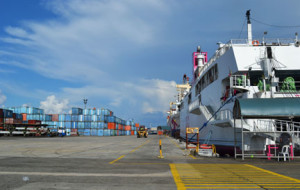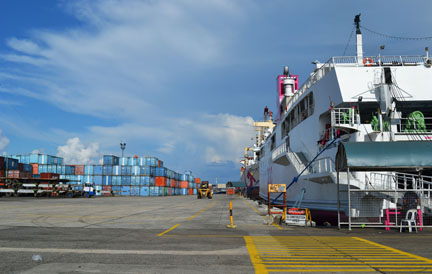
The Philippine Ports Authority (PPA) has intensified preparations for the Association of Southeast Asian Nations (ASEAN) integration in two areas—increasing cargo handling capacity to accommodate the expected influx of cargoes and making policy changes to improve service delivery.
PPA said that to meet the first goal, it will enhance cargo handling capacity of three gateway ports—Iloilo, Zamboanga, and General Santos—in the coming weeks using internally generated funds.
Existing cranes at these ports are not enough to handle the projected volume growth that will come with the breakdown of trade barriers in the ASEAN Economic Community (AEC), PPA said.
Thus, the authority commissioned a study to “determine structural soundness of existing facilities of the three ports to accommodate the wheel load of shore cranes,” said PPA general manager Atty. Juan C. Sta. Ana in a statement.
“These gateway ports handle a considerable volume of containerized cargoes, hence, require efficient quay crane operations in preparation for the AEC implementation,” Sta. Ana explained. “We have to equip our ports with the needed cargo handling muscle to accommodate all these demands.”
PPA said since early last year it has been stepping up efforts to improve major ports’ facilities. The port authority chief said the four Philippine gateway ports of Manila International Container Terminal, Manila South Harbor, Manila North Harbor, and Batangas in Luzon have already achieved sufficient cargo handling capacity in time for the launch of the AEC. Meanwhile, three other gateways—Cagayan de Oro, Davao, and Ozamiz in Mindanao—are also getting ready for the integration.
Aside from major ports, repair and maintenance works for 115 ports under PPA’s watch are ongoing to ensure “they respond to existing economic times particularly on safety, security and convenience.”
Policy updating
Moreover, the authority has been aligning compliance measures with agreements forged by ASEAN members to bring about integration.
“This year, we are expected to introduce breakthrough changes in our policies, particularly in the streamlining of our requirements, more deployment of technology-driven processes to improve the delivery of our services, and reform in the modality of adjusting cargo-handling tariff and other charges and fees,” Sta. Ana said.
PPA is in the last stages of its initiatives to harmonize its rules and regulations with those in the regions, particularly policies related to customs, immigration, quarantine, and security.
The authority is also partnering with global training institutions like the World Maritime University to train junior and senior officers in such areas as port operations.
Sta. Ana said the Philippines as a maritime nation will benefit from the partnerships “particularly now as we bat to become one of the maritime superpowers in the world in terms of port operations, shipbuilding, and manning and crewing.”
The program for PPA senior and junior officers, as well as other qualified personnel, is expected to complement the succession plan for the next batch of PPA officers, Sta. Ana said.
Cruise tourism hubs
In addition, the agency is continuing several projects from last year in support of government vision to promote the country as one of Asia’s cruise tourism hubs, mainly by developing several cruise ports in Davao, Bohol, Boracay, Cebu, Manila, Puerto Princesa, Subic, and Zamboanga. These port areas make up the country’s major nautical cruise arteries.
Lined up too are various programs to develop cruise terminals in the ports of Puerto Princesa, Currimao in Ilocos Norte, and Catagbacan in Bohol.
“The Aquino Administration is coming to a close and before it ends, we are proud to say that the Philippine Ports Authority has done its part in making trade and tourism vibrant again,” Sta. Ana said.
“We are encouraging those who are next in line to continue the progress and changes we already introduced towards the overall dream of the Philippines to become a maritime super power,” Sta. Ana added.





